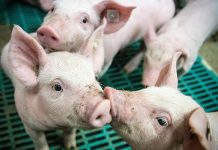Robyn Joubert.
When two Durban landscapers purchased a 3,2ha tunnel farm near Craigieburn on the KwaZulu-Natal South Coast earlier this year, they hit the ground running. “Our original intention for the land was to start an indigenous nursery to supply our respective landscaping and gardening businesses,” says Gregg Smith. “But when we found a lovely piece of Africa with hydroponic tunnels already set up, we realised the potential of growing a food crop while we set up the nursery.”
Gregg and his partner Lee Human decided on cucumbers as that was what the previous owner had grown. “But we didn’t realise the extent of the work that would be involved,” laughs Lee. The land, which the partners named Native Farms, was purchased in May and was in dire need of maintenance and a huge tidy up. With only three tunnels included in the sale price, they paid an extra R85 000 to purchase five other tunnels on the property.
Upgrading the homestead for staff and purchasing hydroponic feed and equipment such as a packaging machine and scales, added substantially to the start-up cost. A t the end of May, only a month after taking ownership of the property, the pair purchased 4 000 cucumber seedlings, at a cost of R10 600. The seedlings were planted in bags of meranti woodshavings, sourced from a nearby sawmill. bags were fed by drip-line irrigation and were stocked at 1 500 bags per 28m x 7m tunnel.
Six weeks after planting, Native Farm’s team of three permanent staff started harvesting cucumbers twice a week. By September, they had harvested 16 000 cucumbers, a figure which should rise to between 20 000 and 25 000 by the end of the season. Cucumbers are wrapped and hand-graded into either Grade or B grades and taken to Delta Market Agents at the Durban Fresh Produce Market.Grade cucumbers fetch about R6,50 per cucumber and Grade about R4,50.
“One of the major lessons we learned was the need to put better windbreaks in the tunnels. If the wind blows, the stalk scratches the skin and the cucumber is immediately downgraded to B,” explains Lee. If the season continues as it began, income from the cucumbers should pay for the cost of purchasing the additional tunnels. “That’s what we ultimately wanted,” says Gregg. “We know it will be a long time before we put money into our pockets, but at least we’ve paid for the tunnels and reduced our debt.”
Neither Gregg nor Lee live on the farm and rely on farm manager Nicholas Khumalo to run it while they are attending to their landscaping businesses in Durban. “gained years of hydroponic experience when he worked at Cato Manor Technical College and our other two staff members, Thobeka and Sindiswe Ginya, are very good at getting on with their jobs in our absence,” says Lee. “But having permanent supervision would definitely result in a better crop and we would have more time to get the tunnels up to standard.” Although the tunnels are in need of maintenance such as pulling up the plastic to do groundwork, it will have to wait until the harvesting is finished.
Learning hard lessons
“We jumped into this crop,” says Gregg. “Ideally we should have done the groundwork beforehand to ensure we had an optimum growing environment for the cucumbers. The state of the tunnels can lead to a lot of problems with pests and diseases. We’ve learnt that tunnels need to be really clean and sterile.” The main problems have been powdery mildew and white fly. The staff constantly check for pests and diseases, which tend to drop off in winter.
The seedlings were planted in two groups with a two-week delay in between, the second group was exposed to a higher level of pests than the first. “The first group obviously matured first and as the crop progressed towards the end of its life, it became more prone to disease. This meant that the younger plants, which were growing alongside the older ones, were exposed to more diseases at an earlier stage. Unfortunately, planting in two stages was unavoidable due to supply constraints, but next year we won’t make the same mistake,” says Lee.
Rushing into the crop also meant that they didn’t have time to thoroughly research the variety best suited to the climate. “It led to glitches along the way which we could have avoided,” says Lee. “We planted Discover and have had a problem with rosetting, which is when the plant produces multiple cucumbers per node and makes for a lot of extra pruning. This variety doesn’t seem to cope well here with the sudden drop in temperature from day to night. We are now running a trial with a variety called Hydra F1 and that seems to be growing a lot better.”
Something else the partners are considering doing differently next season is germinating their own seed. “This will allow us to almost halve the cost of having seedling trays delivered to us,” says Lee. Water from the nearby Umkomaas River provides good, clean irrigation water, they say. “We test the pH and keep the EC constant at around 2. We played it safe with a high EC this time, but as we gain more experience, we can look into different EC techniques to save fertiliser costs which are currently in the region of R1 000 a week.”
The partners are pleased to be producing a food crop that brings in quick cash and allows them to pursue their real passion – indigenous plants. “We want to start an indigenous nursery,” says Gregg, “and while we’re establishing our plant material, the hydroponic food crop will keep the cash flow ticking over. It’s a mix that should work for us in the long term.” Despite the hiccups encountered along the way, Lee and Gregg have no regrets. “We’ve learnt a lot. But next time we will plan better,” concludes Gregg. |fw








